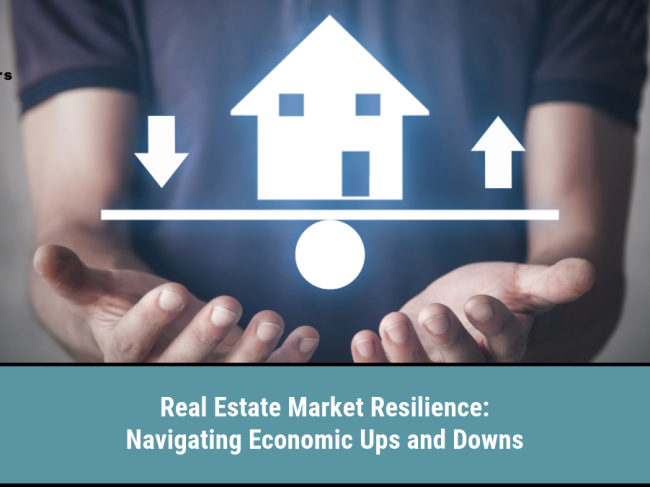Real Estate Market Resilience: Navigating Economic Ups and Downs

Real estate market dynamics, ever-resilient like a roller coaster’s thrilling highs and lows, invite a closer look at their enduring strength. This market remains a beacon of opportunity for investors, homeowners, and renters, regardless of the economic backdrop. Join us in this engaging discussion as we explore the real estate market’s robust resilience in the face of modern economic challenges, and uncover why it stands as a steadfast investment choice.
Understanding the Homebuying Market
To comprehend the concept of resilience in the homebuying market, it is crucial to grasp its fundamental nature. Essentially, the homebuying market involves the buying and selling of properties, encompassing homes, commercial buildings, and land. This market is influenced by a multitude of factors, including supply and demand, interest rates, job growth, and government policies.
- Influential Factors: Market dynamics are influenced by supply, demand, interest rates, job growth, and government policies, crucial for informed decision-making.
- Regional Variations: Local economic conditions, population growth, and housing trends can significantly impact property values and market trends in specific areas.
- Historical Appreciation: Real estate has a history of long-term value appreciation, an important consideration for buyers and investors.
Resilience in Homebuying
The homebuying market has consistently shown an exceptional ability to bounce back from economic challenges across history, thanks to several key contributing factors. One of these factors is the recognition of homes as tangible assets, distinct from more volatile investments like stocks. Even in the midst of economic downturns, people have a continuous need for places to live, and businesses require physical locations to operate. This inherent demand for physical spaces ensures that homes maintain their value over time.
Another significant aspect contributing to the resilience of the homebuying market is the inelasticity of housing. Housing represents a fundamental human need, leading to a relatively steady demand for homes. During periods of economic crises, individuals may temporarily postpone their plans to buy or sell properties, but they ultimately return to the market as their confidence in their financial stability is restored.
Furthermore, diversification plays a crucial role in bolstering the resilience of the homebuying market. Including homes in an investment portfolio diversifies risk by spreading investments across various asset classes. This diversification ensures that even when the stock market experiences volatility, homes can serve as a stable and reliable anchor for long-term investors. Many homebuyers and investors opt for a long-term perspective, which makes them less susceptible to the short-term fluctuations often observed in the economy. Their focus centers on the potential for long-term appreciation of their properties, further reinforcing the market’s resilience.
- Tangible Assets: Homes hold value as physical assets, remaining in demand during economic downturns.
- Housing’s Inelasticity: The need for housing remains constant; people return to the market when financial confidence is restored.
- Steady Rental Demand: The rental market provides stability as people seek housing solutions in various economic conditions.
- Government Intervention: Government policies, like incentives and mortgage support, can stimulate the housing market during economic challenges.
Navigating Economic Ups and Downs in Homebuying
Navigating the homebuying sector effectively amid economic fluctuations requires a comprehensive approach. To begin, staying well-informed is essential, involving diligent monitoring of economic indicators, interest rates, and local homebuying trends. This practice equips you with a deep understanding of market conditions, enabling you to make informed decisions. Furthermore, diversifying your investment portfolio is a key strategy. This entails including various property types, such as residential properties, commercial spaces, and real estate investment trusts (REITs). Diversification enhances the resilience of your investments, making them better prepared to withstand economic downturns.
Understanding the importance of timing is crucial. While perfectly timing the market is challenging, awareness of economic cycles can be advantageous. Buy homes during market downturns when prices are favorable, but be cautious when assessing financing options, keeping an eye on interest rates and financial choices. Cultivate adaptability and patience, adjusting your strategy as economic conditions change. Consider retaining properties during downturns, as patience can yield valuable opportunities. Seek professional guidance from homebuying companies, financial advisors, and legal experts, as their insights can aid well-informed decisions in the complex and ever evolving homebuying market.
Conclusion
The homebuying market’s resilience stands as a testament to the enduring value of homes. Whether you are an investor or a homeowner, understanding the factors that underpin this resilience can empower you to navigate the market effectively, even amid economic ups and downs.
In an ever-evolving economic landscape, homes remain a steadfast pillar of financial stability. As you continue your journey within the realm of homebuying, remember that knowledge, patience, and adaptability are key attributes that can enable you to thrive, irrespective of the economic challenges that may arise.
Want a Fast, Fair, No-Hassle Offer on your House?
Need to sell quickly or just don’t want the cost and delays of putting your house on the market and having strangers in and out of your house, possibly for months? We can help!
